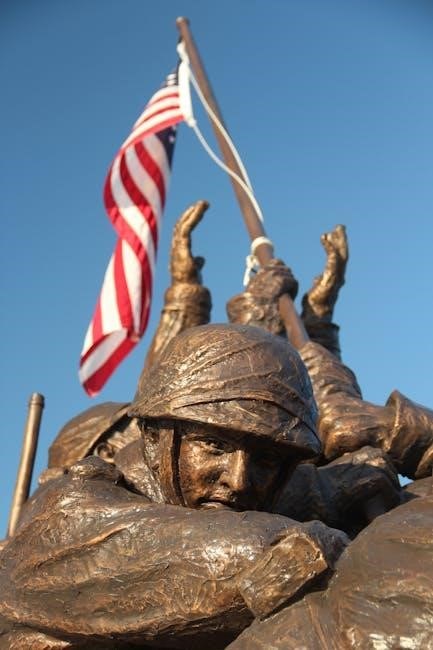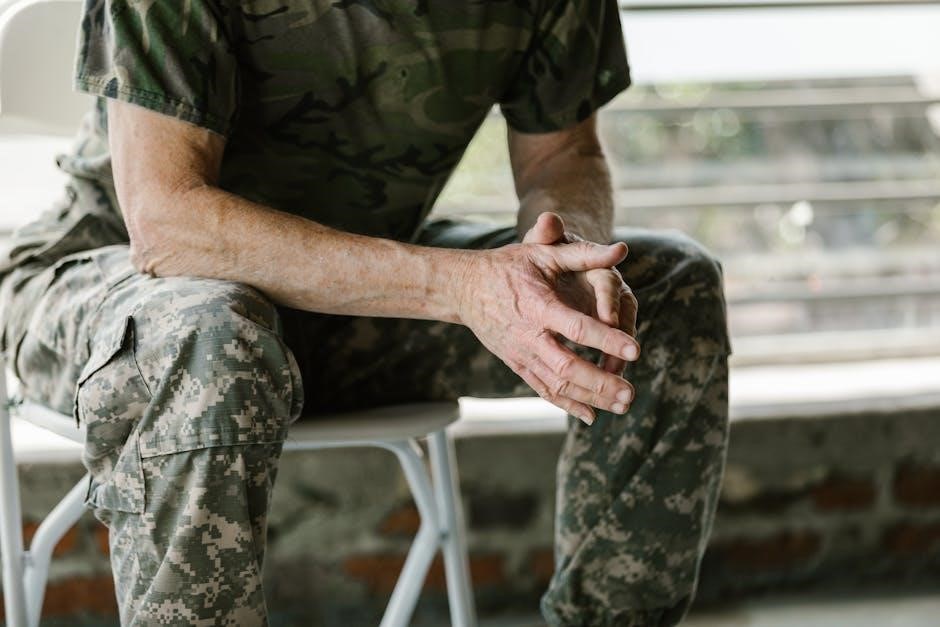The Salvation Army Valuation Guide helps donors accurately assess the value of their contributions, ensuring transparency and fairness in supporting vital community programs.
Understanding the Salvation Army’s Mission and Donation Process
The Salvation Army is a global organization dedicated to eradicating poverty and caring for individuals in need. Their mission focuses on supporting people struggling socially, mentally, and spiritually. When you donate goods, the proceeds fund vital programs, such as Adult Rehabilitation Centers, which help individuals overcome challenges. Donating is straightforward: schedule a pickup or drop off items at nearby locations. The Salvation Army ensures donations are processed efficiently, with proceeds directly supporting community services. By contributing, you help provide hope and opportunities for those in need, aligning with the organization’s commitment to compassion, integrity, and service. Your support makes a tangible difference in transforming lives and strengthening communities.
The Importance of Valuation in Donating to Charity
Accurate valuation of donated items is crucial for both donors and charities like The Salvation Army. It ensures transparency and fairness, allowing donors to claim appropriate tax deductions. Overvaluing or undervaluing items can lead to legal issues, so precision is key. Valuation guides provide a standardized framework, helping donors determine fair market value. This process supports the integrity of charitable giving, fostering trust between donors and organizations. By adhering to valuation guidelines, donors contribute effectively to vital programs, knowing their support is maximized. Proper valuation also ensures resources are allocated efficiently, benefiting those in need. It’s a cornerstone of ethical and impactful charitable giving, ensuring donations make the greatest possible difference.

How Donations Are Valued by the Salvation Army
The Salvation Army values donations based on fair market value, categorizing items like clothing, furniture, and electronics into standardized valuation groups to ensure fair and consistent assessment.

General Guidelines for Valuing Donated Items
The Salvation Army provides guidelines to help donors determine the value of their contributions. Items are valued based on their fair market value, considering their condition, age, and demand. Donors should assess clothing, furniture, and household goods at the price they would sell for in a thrift store. Electronics and appliances are valued based on their working condition and market demand. The Salvation Army also offers resources to help donors estimate values accurately. It’s important to note that items must be in usable condition to be accepted. Donors can use online valuation tools or consult the Salvation Army’s valuation guide for specific categories. Accurate valuation ensures donations are processed efficiently and support vital community programs effectively.
Specific Valuation Categories: Clothing, Furniture, and Household Items
Clothing, furniture, and household items are among the most common donations. Clothing is valued based on its condition, age, and type, with fair market value typically ranging from $0.50 to $5 per item. Furniture is assessed for its structural integrity, material, and demand, with values varying widely depending on the piece. Household items, such as kitchenware or linens, are valued based on their usability and condition. Donors should consider the price similar items would sell for in a thrift store. The Salvation Army provides detailed guidelines to help donors estimate these values accurately, ensuring contributions are fairly assessed and maximized to support their mission.
Special Considerations for Electronics and Large Appliances

Electronics and large appliances require careful valuation due to their varying conditions and market demand. Functional items like TVs, computers, and refrigerators are typically valued higher than non-working ones, which may only be suitable for recycling. Donors should consider the item’s age, brand, and whether it includes original accessories or manuals, as these factors can significantly impact value. Non-working items generally have little to no tax-deductible value. The Salvation Army recommends researching comparable prices for similar items in thrift stores or online marketplaces to determine fair market value. For high-value items, professional appraisals may be necessary. Always ensure items are clean and in working condition to maximize their contribution value.

Tips for Donors to Maximize Their Contributions
Organize donations, research fair market values, and ensure items are clean and functional to enhance their worth and support Salvation Army programs effectively.
How to Research and Determine Fair Market Value
Determining fair market value (FMV) is crucial for accurate donation valuation. Start by researching similar items in thrift stores or online marketplaces like eBay or Craigslist. Compare prices of items in similar condition to ensure a realistic assessment. For electronics and appliances, check recent sales data or use pricing guides specific to those categories. Keep records of your research, including screenshots or printouts, to support your valuations. Additionally, consult IRS guidelines for charitable contributions to ensure compliance. For high-value items, consider professional appraisals. Accurate valuation not only aids in tax deductions but also ensures proceeds from donations are maximized to support Salvation Army programs effectively.

Organizing Donations for Efficient Valuation and Processing
Organizing donations is key to efficient valuation and processing. Separate items by category, such as clothing, furniture, and household goods, to streamline the assessment process for Salvation Army staff. For clothing, sort items by type and condition, ensuring each piece is clean and intact. Furniture should be disassembled if possible and accompanied by all necessary parts. Household items like kitchenware or electronics should be grouped together, with any accessories included. Clearly labeling each category helps staff quickly identify and value items. Additionally, providing a detailed list of donated items can aid in accurate valuation and ensure donations are processed promptly. Efficient organization not only saves time but also maximizes the impact of your contributions, supporting Salvation Army programs more effectively.

The Impact of Your Donations
Donations support Salvation Army programs, aiding in the rehabilitation and empowerment of individuals facing social, mental, and physical challenges every day.

How Proceeds Support Salvation Army Programs
Proceeds from donations fund critical Salvation Army programs, including Adult Rehabilitation Centers, which help individuals overcome addiction and rebuild their lives. These centers provide housing, counseling, and job training, empowering people to regain independence. Additionally, donations support community outreach initiatives such as food banks, disaster relief efforts, and youth development programs. The funds also contribute to emergency shelter services and educational resources for underserved populations. By donating, individuals directly contribute to transforming lives and strengthening communities. Every item sold in Salvation Army stores supports these vital programs, ensuring that the organization can continue its mission of caring for those in need. Your contributions make a tangible difference in the lives of many.
Success Stories and Real-World Impacts of Donations
Donations to The Salvation Army have transformed countless lives, providing hope and opportunity to those in need. For instance, the Adult Rehabilitation Centers have helped thousands overcome addiction and reintegrate into society through comprehensive recovery programs. One inspiring story is that of Rebecca Aleck Koltun, who, despite a tragic accident, continues to inspire others with her resilience. Community outreach initiatives funded by donations have also provided essential support during disasters and economic hardships. By contributing to The Salvation Army, donors directly enable life-changing services and programs that uplift individuals and families. These success stories highlight the profound impact of generosity and the ripple effect of kindness in communities worldwide.

Common Mistakes to Avoid When Valuing Donations
Avoid ignoring official guidelines or using outdated resources when determining item values, as this can lead to inaccurate assessments and potential issues with tax deductions.
Overvaluing or Undervaluing Items: Why Accuracy Matters
Accurate valuation of donated items is crucial for ensuring fairness and compliance with tax regulations. Overvaluing items can lead to rejected donations or legal issues, while undervaluing may result in missed revenue for charitable programs. The Salvation Army relies on precise assessments to allocate funds effectively to their initiatives, such as the Adult Rehabilitation Centers. Donors should use fair market value guidelines to avoid these pitfalls, ensuring their contributions make the greatest impact. Transparency and honesty in valuation help maintain trust and support for the organization’s mission to combat poverty and empower communities.
Avoiding Common Errors in Donation Valuation
Donors often make mistakes when valuing items, such as assigning sentimental values or ignoring market trends. To avoid these errors, research current market prices and consider the item’s condition. The Salvation Army advises using their valuation guide to ensure accuracy. Separating items into categories like clothing, furniture, and household goods helps in applying the correct valuation standards. Additionally, items like electronics and appliances require special attention due to rapid depreciation. By following these guidelines, donors can ensure their contributions are fairly valued, benefiting both the charity and the donor’s tax deductions. Accurate valuation supports the Salvation Army’s mission to fund vital community programs effectively.
By following the Salvation Army Valuation Guide, donors can confidently contribute items that support life-changing programs while receiving fair tax benefits, fostering a positive community impact.
Encouragement to Donate and Support the Salvation Army’s Mission
Your donations to The Salvation Army make a tangible difference in transforming lives. By contributing items like clothing, furniture, and household goods, you directly support local rehabilitation programs that empower individuals to overcome challenges. The proceeds from these donations fund vital services, including food, shelter, and job training, helping people rebuild their lives with dignity. Your generosity not only declutters your home but also becomes a lifeline for those in need. Consider organizing your donations to ensure efficient processing and maximize the impact of your support. Together, we can create a ripple effect of kindness and hope in our communities.